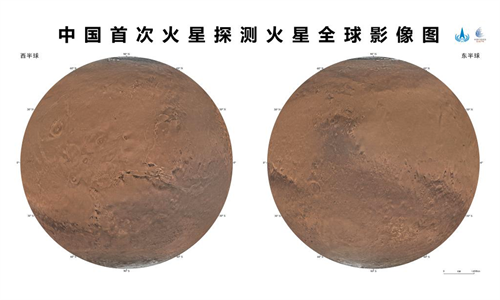
Photo released on June 11, 2021 by the China National Space Administration (CNSA) shows a selfie of China's first Mars rover Zhurong with the landing platform. (CNSA/Handout via Xinhua)
An international team of researchers led by Chinese scholars has made another groundbreaking discovery on the surface of Mars. By analyzing data obtained from the multi-spectral camera onboard the Zhurong rover, they have found evidence of marine sedimentary deposits, providing the first geological proof of the existence of an ancient ocean in the northern region of the Red Planet.
The discovery has opened up new possibilities for unraveling the planet's past and its potential for hosting life.
The research, titled "Evidence of Oceanic Sedimentary Rocks in Utopia Planitia: Observations from the Zhurong Rover," led by Long Xiao, professor from the School of Earth Sciences at China University of Geosciences, was published on Thursday in the prestigious scientific journal, National Science Review.
Mars is now known for its cold and arid conditions. However, the latest discovery suggests that the Martian environment might have been significantly different billions of years ago, Science and Technology Daily reported on Friday.
Previous studies have confirmed the presence of abundant liquid water on early Mars, and the hypothesis of a primordial ocean has been proposed based on geological analysis and numerical simulations. However, the lack of in-situ data has compromised substantial support for this hypothesis.
Thus, the question of whether there was an ocean in the northern plains of Mars has remained a controversy.
In 2021, China's first Mars exploration mission Tianwen-1 successfully landed the Zhurong rover in the southern region of Utopia Planitia, located in an area known as the North Plains Formation. This landing provided an opportunity to investigate the existence of ancient oceanic deposits.
Covering a distance of about 1,921 meters, the rover has used various imaging and analysis tools to conduct detailed in-situ observations of surface rocks. The navigation and terrain cameras have captured 106 sets of panoramic images, documenting the surface morphology and structural features of numerous rocks along its path.
"When we examined the photos sent back by those cameras, we found that these exposed rocks exhibited distinct layering structures, which were significantly different from the common volcanic rocks found on the Martian surface or the layering structures formed by wind-blown sand deposits," Long said.
"These layering structures indicate the characteristics of bidirectional water flow, consistent with the low-energy tidal currents observed in terrestrial coastal environments on Earth," the professor stressed.
As all observed rocks were within Zhurong's survey area, the research team named the representative geological unit "Zhurong."
The results of the Zhurong rocks constitute the first direct in-situ evidence supporting the existence of an ancient ocean in the northern plains of Mars. It also suggested that the observed sedimentary structures might have formed during the retreat of the ancient ocean in the area.
This research provides new insights into reshaping the understanding of Mars' history. "Future exploration and sample return missions to this region will further deepen our understanding of Mars' habitability and the preservation of traces of life," Long remarked.
Global Times


